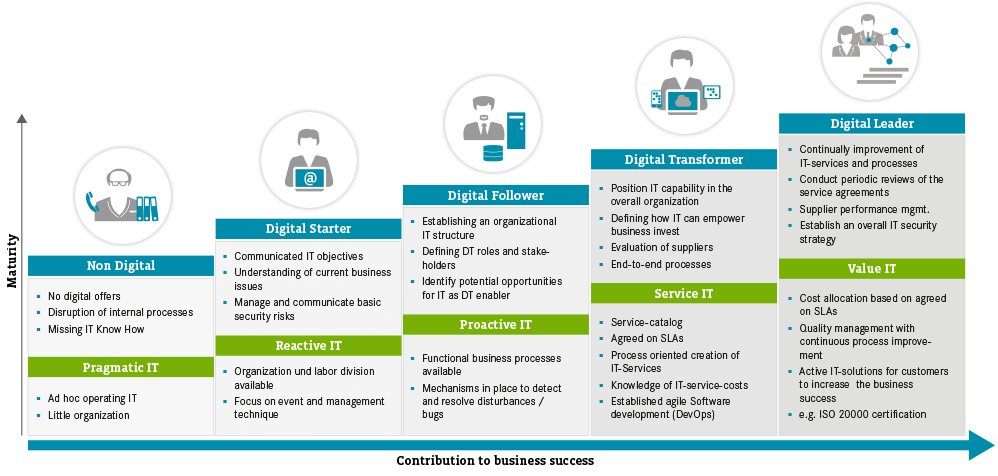Sometimes, the digital transformation process does not start with spectacular fireworks. Rather, the secret prerequisite for the digital transformation is a transformed internal IT environment. The question of the hour: How can companies with a modern IT organization and process infrastructure lay the foundation for the digital transformation?
Based on our experience, this topic often does not receive the attention it deserves. But why is that? Maybe because it concerns tasks that were already known previously, but that are becoming critical to the business now. While many large companies have already progressed in this area, medium-sized companies still have some catching up to do, even though most medium-sized companies are well positioned when it comes to their IT organizations. But considerable potential for improvements exists with the establishment of a service-oriented IT environment. Therefore this is not so much about (a lack of) technological competence, but rather about establishing the organizational skills to ensure that one does not miss the digital train, so to speak.
A typical example - the supplier company
A supplier company manufactures sensors for the automotive industry, and it has already made a lot of progress with its product IT and production IT.
The company continues to acquire smaller companies in the industry. With that, it also acquired the differently developed structures of each of these companies, which have remained. To date, none of the companies is well integrated; at best, simple infrastructure services such as storage or networks have been rolled out.
The internal (office) IT operates in the shadows, and is actually only administered - leading the IT organization into a new age and to a new key position is not perceived as a leadership task.
To be able to introduce new digital services such as analytics, big data, IoT or Industry 4.0, the supplier company's IT must be modernized as quickly as possible - now things get hectic!
And it gets worse: The lack of integration and consolidation of the different IT departments at the acquired companies stands in the way of being able to offer the new digital services across the entire company.
Just like the supplier company, many medium-sized businesses are still a long way from organizing their IT systems properly, finding the right partners and creating real added value for their business. So what needs to be done?
The digital transformation adds even more urgency to the existing IT homework
The future orientation of IT as a modern process organization is always a major task that needs to be completed. The task becomes even more urgent, and downright non-negotiable, for creating the internal conditions for the digital transformation. Here, we see a minimum program consisting of three action fields (see also illustration):
- Continuous process orientation in the IT organization, from demand management to IT governance.
- The business processes are independent, but the IT processes are not. That means that IT follows the business processes / value chains in the processes, applications and architecture.
- Make or Buy: Which capabilities of the company's own IT are considered system-relevant, and must be maintained as core competencies? And: Which IT capabilities represent a relevant unique selling point? The rest should and must be outsourced.
These three action fields are not enough, however. There is another important issue that must be considered.
Involvement of management - but why?
Deliberations about the role of IT must also include thoughts about the requirements for the IT Manager role. It is not sufficient if the understanding of leadership only centers on a pragmatic-reactive IT organization. Because: IT can only be as innovative and agile as the IT Manager. Therefore the involvement of management is critical to success. But let's be honest - this statement is hardly new. So what does it mean specifically in our case?
Management must specify what it wants from IT: in what role does it see the IT system, what is the IT organization's future value contribution to the digitization of the company? Ideally, management will initiate and moderate the process. At the end of the process, the following question should be answered: How has the new role of IT been defined in the company, led by the departments that are close to the customer?
Leadership in IT
The digital transformation requires customer- and innovation-based leadership in IT. This leadership must target a new service-oriented IT organization, which is closely linked to the areas that are close to the customer. Three implementation principles have proven themselves in this context:
- Each measure of the new IT organization has been designed in such a way that its benefit can be measured on a regular basis.
- Employees are included in the process as early as possible, so that they can accompany and support the digital and cultural transformation in the IT organization from the beginning.
- Best practices from outside or from other companies are not only desirable but mandatory - they massively accelerate the learning and implementation curve.
And finally: Waiting for the others???
You do not have to wait for the others, you can take the first step yourself: What do you want from the IT organization in your company? What is its strategic role? Which three business processes should be strategically supported by IT in the short term through modified applications and solutions?
With your answers, you make an important contribution towards ensuring that the transformation of the internal IT organization becomes a driver for the digital transformation of the entire company.

